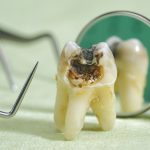What’s In The Water?
How often do you think about what is in your tap water before you drink it? Most of our drinking water is drawn from reservoirs like the one at Lake Ray Hubbard, Lake Lewisville, or Lake Grapevine.
In addition to natural minerals found in our water, fluoride is added to our water system. To keep our drinking water safe and to harness the natural benefits, it takes a significant amount of science and technology to meet today’s expectations. Thanks to this, our drinking water is not only able to help nourish our body, but protect our teeth as well!
Keep reading to find out how fluoride has changed history and the benefits it has for our teeth!
History of water fluorination
The initial study of fluoride in water occurred in the early 20th century in Colorado. These early studies that were spurred by most residents having brown stains on their teeth, which created a groundswell in research on the correct levels of fluoride in water. Through this study dentists and researchers were able to identify how fluoride in the water effects the teeth along with the adverse effects of too much fluoride (leading to brown stains).
Subsequent studies were built on the early research to test the hypothesis that correct fluoride levels in the water were beneficial to oral health and helped prevent cavities. Working with the U.S. Public Health Service team, researchers published studies confirming that fluoride was beneficial to long-term oral health. These early studies that compared cities with fluoride in the water to cities without prompted Grand Rapids, Michigan to be the first city in 1945 to add fluoride to the water for the dental benefit.
Since 1945, hundreds of cities have started community water fluoridation, and in 2012 nearly 75% of the United States served by community water systems had access to fluoridated water. Because of its contribution to the dramatic decline in tooth decay over the past 70 years, the CDC named community water fluoridation as 1 of 10 great public health achievements of the 20th century.
Unfortunately, over 100 million Americans still do not have access to water with fluoride. Since it is so beneficial (saving teeth and money), the U.S. has made it a goal to have 80% of all American households have access to fluorinated water by 2020.
How does it work?
While all water contains some fluoride naturally, in most instances it’s not enough to prevent cavities or to provide an oral health benefit. Bad bacteria in the mouth produces acid, which can cause tooth decay or other oral health problems. Fluoride acts as a barrier and strengthens the tooth enamel. To that end, water fluoridation prevents tooth decay by providing frequent and consistent contact with low levels of fluoride. By keeping the tooth strong and solid, fluoride stops cavities from forming and can even rebuild the tooth’s surface.
Guidelines for water fluoridation
In 2015, the federal government revisited the guidelines for the levels of fluoride to be included in water. The level was lowered from 1.2 milligrams per liter to .7 milligrams per liter. This change was made to account for the growing number of cases of fluorosis and as a result of Americans receiving fluoride from a variety of sources—not just drinking water. If you’re curious about the levels of fluoride in your drinking water, the Centers for Disease Control and Prevention releases a list that your explore.
If you are concerned about what is in your drinking water (both fluoride levels or other natural minerals) then give our office a call today. Dr. Ku will be happy to review local water reports and analyze the data for you.






